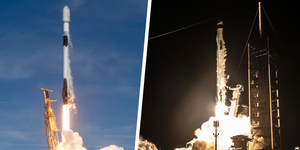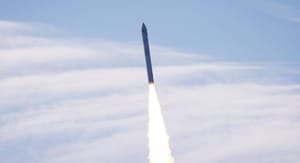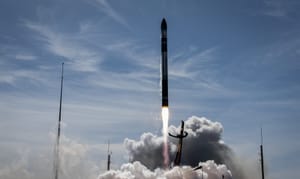
SpaceX has been keeping up its groundbreaking cadence so far this year after a record-breaking year of launches in 2023. Between the Early hours of the 4th and 5th of March, SpaceX launched its Falcon 9 rocket three times from three different launch pads on two sides of North America.
This comes with a series of records that SpaceX has now broken. The three launches took place within the span of twenty hours and three minutes, and two of the launches took place one hour and fifty-one minutes apart. This was also the first time SpaceX is believed to have been operating two second-stages on orbit simultaneously.
The record for three launches previously stood at twenty-three hours and four minutes. The previous record for two launches stood at two hours and fifty-five minutes.
These records are broken as SpaceX is hoping to launch at least one-hundred and forty-eight times this year. To reach the goal SpaceX needs to launch twelve Falcon 9's each month. As of writing SpaceX has completed twenty-two of the launches needed for this goal.
If SpaceX hits its goal it will raise the record again after the company achieved ninety-six launches last year with Falcon 9.
What were the three missions?
(These times are in Universal Coordinated Time.)
03:53 am March 4th - Crew 8

The first of the three missions was Crew-8 from Launch Complex 39A, in Florida. This mission sent four astronauts into orbit where they will soon board the International Space Station. The astronauts of the Crew-8 mission are Commander Matthew Dominick, Pilot Michael Barratt, Mission Specialist Jeanette Epps, and Mission Specialist Alexander Grebenkin.
This mission used booster B1083 on its first flight, the booster landed back at Landing Zone-1, in Florida, as planned. The Crew Dragon capsule for Crew-8 is Endeavor on its fifth flight to orbit.
This was also the thirteenth time SpaceX has flown people into space overall.
10:05 pm March 4th - Transporter 10

The second mission was Transporter 10 from Space Launch Complex 4E, in California. This mission delivered fifty-three satellites into a sun-synchronous orbit.
This launch is, as the name suggests, the tenth mission under its Transporter dedicated smallsat rideshare program, which aims to offer an affordable launch option for small spacecraft.
The mission had its final payload separation events early on the 5th of March.
The booster used for the Transporter-10 mission was B1081 making its fifth flight, the booster landed at Landing Zone 4, in California, as planned. B1081 has previously supported the Crew-7, CRS-29, Starlink Group 6-34, and PACE missions.
11:56 pm March 4th - Starlink Group 6-41

The third and final launch was Starlink Group 6-41 from Space Launch Complex 40, in Florida. This mission sent twenty-three Starlink satellites into low Earth orbit to grow the company's space-based internet constellation.
This mission concluded with the booster landing and Starlink deployment in the early hours of the 5th of March.
The booster for this mission was B1073 making its thirteenth flight, which landed on the drone ship 'A Shortfall Of Gravitas' downrange as planned. B1073 has previously supported the Starlink Group 4-15, SES-22, Starlink Group 4-25, Starlink Group 4-35, HAKUTO-, Amazonas Nexus, CRS-27, Starlink Group 6-2, Starlink Group 5-11, Starlink Group 6-12, Starlink Group 6-27, Starlink Group 6-37 missions.
What is Falcon 9?
Falcon 9 is currently the world's only operational partially reusable medium-lift launch vehicle. The rocket is manufactured and operated by American aerospace company SpaceX. Falcon 9 currently launches from Vandenberg Space Force Base, in California, and Cape Canaveral, in Florida.
For recovery, Falcon 9 has four grid fins and four landing legs on the first-stage. The first stage either lands vertically on a drone ship or on a landing pad back at its launch site, landing back at the launch site causes a reduction in payload capacity.
SpaceX claims that Falcon 9 can send up to 22,800 kilograms into low Earth orbit when expended or 18,400 kilograms when reused. Similarly, it can send up to 8,300 kilograms into geosynchronous transfer orbit when expended or 5,500 kilograms when reused.
The first-stage is powered by nine Merlin 1D engines burning rocket-grade kerosene and liquid oxygen to generate 771 tons of thrust for up to two-minutes and forty-two seconds of burn time.
The second-stage is powered by a single Merlin 1D vacuum engine burning rocket-grade kerosene and liquid oxygen to generate 95 tons of thrust for up to six minutes and thirty-seven seconds of burn time.
On the pad, the rocket is 70 meters tall with the first and second stages 3.7 meters in diameter, the fairing is 5.2 meters in diameter and tapers out from the top of the second-stage. Fully fuelled Falcon 9 weighs approximately 549,000 kilograms.



